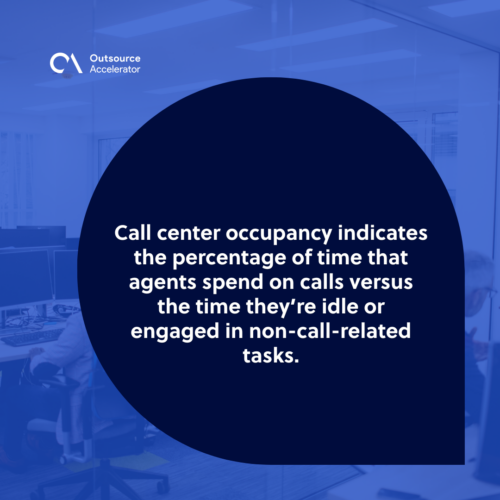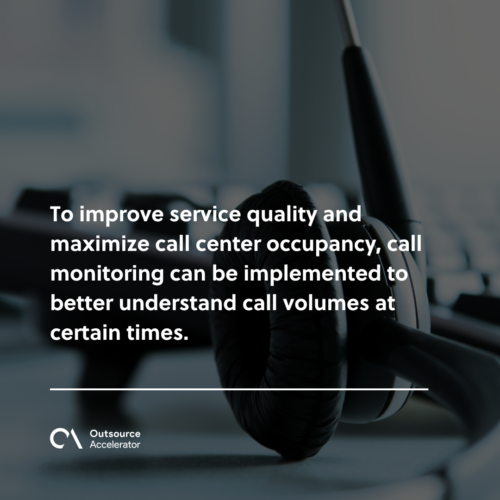Call center occupancy
Definition
What is call center occupancy?
A common contact center performance metric is call center occupancy. It indicates the percentage of agents who spend time on calls versus their idle time or engaged in non-call-related tasks.
Call-related activities include conversation time, wait time, and after-call work time (ACWT).
Occupancy is often associated with utilization, but the two terms vary. Utilization helps determine overall time spent at work.
This includes training sessions and team meetings, whereas occupancy simply factors in the time when representatives are active in the call center.

How are occupancy and utilization related?
Occupancy and utilization are closely related concepts, especially in the context of various spaces and resources.
Let’s break down the relationship between occupancy and utilization:
Occupancy
Occupancy refers to the presence of individuals or entities in a given space or the use of resources.
In the context of a building, occupancy is the number of people present in a room, floor, or the entire structure at a specific time.
Utilization
Utilization is the extent to which a space, facility, or resource is being used or the degree to which it is in operation.
For a meeting room, utilization measures how often and for what duration the room is used for meetings.
Factors influencing call center occupancy
Several factors influence call center occupancy:
Staffing levels
The number of available agents compared to the incoming call volume is critical. Insufficient staffing can result in higher occupancy rates as agents handle more calls simultaneously.
A low agent occupancy rate indicates that your workforce exceeds the necessary staffing levels.
Workforce management systems
A workforce management system is the strategic engine that drives staffing and resource allocation for customer interactions within a contact center.
Investing in robust workforce management systems streamlines call center operations scheduling, forecasts your call center efficiency volumes, and empowers your agents to be at the right place at the right time.
Call abandonment rate
Imagine a call as a conversation – if someone hangs up before it even starts, you miss a chance to connect.
Monitoring and minimizing call abandonment rates directly impact your call center occupancy, ensuring every customer interaction still counts.
Challenges and solutions in contact center occupancy
Here are some challenges associated with contact centers, low occupancy rate suggestions and potential solutions:
Burnout among agents
Agent burnout is the dark cloud that looms over calls, and most contact centers. Addressing this issue is not just about preventing burnout; it’s about nurturing a work environment.
Technological hurdles
Embracing technology is essential, but it comes with its challenges.
Overcoming technological hurdles requires patience and a strategic approach to ensure customer satisfaction and smooth operations.
Customer expectations
Meeting customer expectations is vital. Understanding customer demand and aligning with those expectations is needed to maintain a high call center occupancy rate while keeping customers satisfied.
How to calculate occupancy
Understanding the occupancy rate during various days, seasons, and time periods enables you to optimize schedule time agents more efficiently.
In the call center, the total handling time and the available time are important factors.
The contact centers would have to keep track of the total logged-in time of advisors throughout the day.
Once these figures are available, the call center occupancy can be calculated by dividing the total handling time by the sum of the total handling time and the available time.
Then, you may get the occupancy percentage by multiplying the result by 100.
Top ways to optimize call center occupancy rates
Determining the call center’s occupancy rate can reveal whether the call center has proper staffing. Here are ways to optimize your call center occupancy rate:
Self-service option for customers
This is one of the most important tools businesses employ to reduce the pressure on call centers these days.
Providing consumers with self-service options for requesting service calls and placing and tracking transactions would lower call volumes.
Further, accessing product information would help in maximizing each agent’s occupancy level.
Call monitoring
To improve service quality and maximize call center occupancy, call monitoring can be implemented to understand call volumes at certain times better.
Optimizing the occupancy of each contact center agent during peak hours may significantly reduce the number of times consumers must wait in a queue.
This reduces the amount of time spent on a single call, resulting in increased agent efficiency.
Managers can arrange training sessions and develop redressal programs for agents based on the outcomes of the monitoring process.

Agent utilization during quiet periods
Many contact centers receive large call volumes. However, there may be days when the volume of calls is low.
Contact center managers can direct agents to conduct outbound calls to get service feedback and cross-sell goods of interest.
They may also schedule training courses for agents during quiet periods to achieve the proper balance between taking client calls and lowering call center overheads.
Further, adding excitement to the workplace by establishing a competitive and team-oriented environment will not only inspire call center agents but will also help them improve their performance.
Efficient training programs
Equip your agents with the right skills and knowledge. Like athletes training for a competition, well-trained agents navigate calls smoothly, contributing to a higher occupancy rate.
Call center outsourcing for unpredictable traffic
If forecasting customer traffic was easy, call centers would never encounter any difficulties during their shift. However, forecasting daily traffic is a difficult task.
Outsourcing, on the other hand, is one of the most convenient solutions that call centers might consider in order to supply additional resources during peak hours.
It is preferable to move resources between the primary call center and the outsourced call center rather than requiring agents to answer more calls during busy hours.
This will also guarantee that each employee’s occupancy rate is as high as possible.







 Independent
Independent




